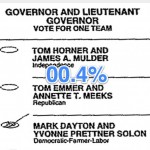 Part of chaos theory is something called the butterfly effect, the notion that even a minor change in a nonlinear system, such as the flutter of a butterfly’s wings, can result in large differences in outcome later on, such as the change in the path of a tornado.
Part of chaos theory is something called the butterfly effect, the notion that even a minor change in a nonlinear system, such as the flutter of a butterfly’s wings, can result in large differences in outcome later on, such as the change in the path of a tornado.
Politics is a decidedly non-linear system, where small changes can definitely cause large swings in outcomes. Here are a few the behind-the-scenes flutters that caused the Vikings to finally prevail in their decade-long effort to secure stadium subsidies at the State Capitol.
A Recount. 00.4% of the vote. That was Mark Dayton’s margin in a general election recount in 2010. As a result, “Landslide Dayton” became the Vikings most powerful and committed supporter.
 But what if Dayton’s 2010 opponent Tom Emmer had not started his campaign so gaffe-prone? What if pennies had not been dumped on Emmer, turning an obscure issue like tip credits into an enduring symbol of an ideologically extreme candidate?
But what if Dayton’s 2010 opponent Tom Emmer had not started his campaign so gaffe-prone? What if pennies had not been dumped on Emmer, turning an obscure issue like tip credits into an enduring symbol of an ideologically extreme candidate?
In a Republican wave election year, it’s easy to imagine that a few small improvements in Emmer’s campaign could have given Emmer an additional 00.5% of the vote, and the helm of state government.
If Emmer had prevailed, he would not have been as aggressively pro-Vikings Stadium as Dayton. MPR captured Emmer’s position in 2010:
“I support a solution for a Vikings stadium, but I don’t think you give $700 million in taxpayer money and hand it over to a private business.”
Emmer suggested a voter referendum linking funds from a new casino to pay for the stadium. He also suggested community ownership (Green Bay Packers model) or giving Wilf the Metrodome.
The Vikings viewed all of Emmer’s demands to be bill killers. So if Dayton hadn’t squeezed into the electoral end zone — after an instant replay review by the officials — the Vikings likely would not have squeezed into their stadium subsidy end zone.
A Leader. Powerful House GOP Speaker Kurt Zellers opposed the Vikings bill. So did powerful House GOP Majority Leader Matt Dean. That could easily have spelled the end for the Vikings. After all, there aren’t too many major bills that pass the House with the leadership of both parties opposing the bill.
 So if the DFL’s highest ranking House member, the often powerless Minority Leader Paul Thissen, had joined Zellers and Dean in opposing the bill, the Vikings fragile coalition probably could not have scored.
So if the DFL’s highest ranking House member, the often powerless Minority Leader Paul Thissen, had joined Zellers and Dean in opposing the bill, the Vikings fragile coalition probably could not have scored.
It’s not often that a minority party leader swings the balance in our polarized Legislature, but Thissen did.
A City Attorney. With the Metrodome site as the only viable option at the end of the session, the whole effort would have collapsed without an endorsement by the Minneapolis City Council, a very tall order at the time. And if Minneapolis City Attorney Susan Segal had not ruled that a city referendum provision didn’t apply to the City’s stadium proposal, because the City didn’t control the funding in question, City Council Member Sandy Colvin Roy made it pretty clear that she would not have been the final swing vote in support of the proposal.
Think about that a minute. If a political pundit had predicted before the session that someone named Susan Segal would be the key to whether the Vikings would get their new stadium, even many political savants would have said “who?”
But Susan Segal, Paul Thissen and 00.4% of Minnesotans all fluttered their relatively small wings, and the Vikings decade-long stadium loss streak finally came to an end.
“A game of inches,” indeed.
– Loveland
Note: This post was also featured as part of the “Best of the Blogs” feature in Politics in Minnesota’s Morning Report.

